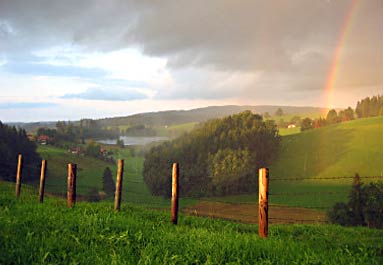This original column is provided free for one-time use with author credit at the end. It may be used for background with author credit. Copyright applies.
#189 FOR IMMEDIATE RELEASE: June 23, 2011
An unsteady hand rests on an unready tiller
By Curtis Seltzer
BLUE GRASS, Va.—I set a record -- at least a personal best and perhaps grander than that -- on June 18th, the day…I finally tilled our garden. Cutting myself a lot of slack, I was at least six weeks late.
In mid-May, my wife, Melissa, placed a hoe -- blade side up -- on the living-room couch where I sit and sprinkled me from her watering can. These nudges were to remind me that she was able, willing and impatient to plant.
Our frost-free season is late May to early September. Tilling is done in early May for lettuce and spinach.
A garden as late as ours will need luck and a dab of global warming to harvest a ripe tomato in late September.
Apart from being lazy and good for nothing, I credit my two months of no-till gardening to the weather.
Every time I had blocked out a couple of hours to till, it either had just rained or was raining. You can’t work wet dirt, because it clumps up on the tiller’s tines and eventually clumps things to a stop. Melissa was quite insistent that she wanted her garden tilled, not clumped.
In the early evening on a clear Friday, June 17th, I unlimbered my early 19th-Century Statesman tiller, refreshed its oils, cleaned its carburetor and WD-40ed any part that threatened to move. I had been assured by the former owner that Jefferson tilled his garden at Monticello with an identical model, pulled by pair of matched mules.
Every year or two another tine breaks during the gardening. If tines were teeth, my tiller has a smile like that of a 50-year-old hockey goalie who never wore a mouthguard.
A front-tine tiller with a couple of surviving snaggle teeth will get the job done…in time. But it requires the upper-body strength of Hercules and the footwork of Baryshnikov in his prime; I’m a little short on both counts.
Pebbles smaller than peas make it kick, rear, jump, bounce, sidestep, dip, lunge and strike like a cobra. These moves inspired two local teens to invent B-boying some years ago as a way to stop baling hay in a 95-degree July. They informed me, their employer, that they had come down with the only known case of Twitch-and-Jerk Disease, an outbreak, I assumed, that was triggered by sweat on their brows. They spent the rest of that summer breakdancing in New York subways, where they were discovered and made into overnight stars—the dance duo known as Stoop Doggy Bags.
Over the years, I’ve considered getting a new tiller, a category that includes a used one that’s new to me. I bought the Statesman at a house auction more than 25 years ago from a woman in her early 80s who tilled a garden that dwarfed a Wal-Mart parking lot. She said she was buying a bigger, new model “to get the horses I need.”
Like many of us who have made it into our mid-sixties, my Statesman tiller has trouble getting moving after sitting still for a long time.
In years past, it would gasp and cough, turn over, work for two hours, then retire to an undisturbed year-long sleep. This June, it gasped, coughed, swallowed three cans of starting fluid, cranked and then sputtered into a silent spring.
After an hour of yanking -- I was yanking the tiller’s cord, and it was, in a manner of speaking, yanking mine -- and fiddling with its mixtures and idles, I gave up, kicked its back wheels and hauled it down the road to Junior’s shade tree for repair.
Since all of its parts were pre-1950 originals, including the spark plug, I figured it might need a tink here or even there.
Junior had it running perfectly the following morning. No need to change the plug. “Six dollars,” he said.
Junior and I share the same belief in nursing motors beyond their hospice years. He is Dr. House who never fails to find a cure for mysterious ailments. He has kept local small engines on life support for decades.
These days, however, we’ve both begun to blame small-engine failures on E10, the 10-percent ethanol now almost universally added to gasoline.
Ethanol, an alcohol made from plants, can rust out metal parts because it attracts moisture. As a solvent, it can also create a gummy residue that clogs small engines. This, I believe, is what “done in” my last chainsaw.
Mechanics and many dealers who sell and service lawnmowers, ATVs, snowmobiles, generators, outboard motors and the like say that E10 damages these simple carburetors. The ethanol lobby says that no harm results, except maybe in small engines built before the mid-1990s.
E15, which is coming, is worse than E10 for small engines.
I’m trying to prevent future damage by buying ethanol-free gasoline. With E10, I use a high-quality mixing oil in the two-cycle motors, keep fuel fresh, store it for less than two months, shake the oil-gas mixture before use and slip in a little Sea Foam Motor Treatment.
An RIP cloud hangs over my antique tiller. Even Dr. House can’t outwit E15 gasoline poisoning.
On the other hand, if E15 kills all small engines, that work will once again be done by hand or mules. Won’t that be fun?
Or not done at all, which would allow me to join the Bags on tour.
Curtis Seltzer is a land consultant who works with buyers and helps sellers with marketing plans. He is author of How To Be a DIRT-SMART Buyer of Country Property at www.curtis-seltzer.com where his weekly columns are posted. He also writes for www.landthink.com.
Contact: Curtis Seltzer, Ph.D.
Land Consultant
1467 Wimer Mountain Road
Blue Grass, VA 24413-2307
540-474-3297
curtisseltzer@htcnet.org
www.curtis-seltzer.com
This original column is provided free for one-time use with author credit at the end. It may be used for background with author credit. Copyright applies.
|









